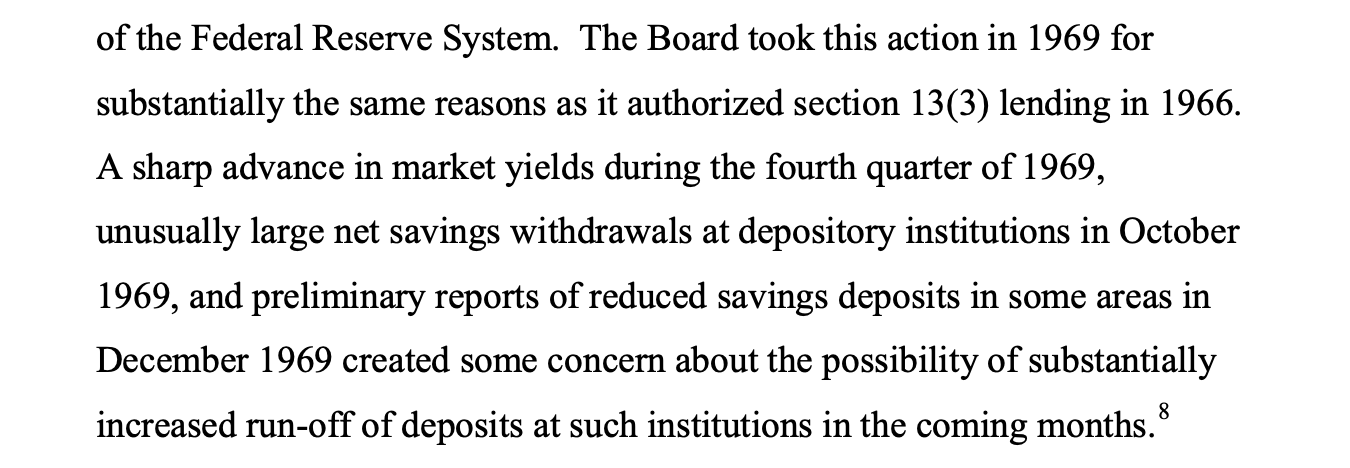Hiking Beyond When Something Breaks
Credit market interventions aren't just for dovish times
The pithy consensus of the Fed’s current strategy is that it’s raising rates “until something breaks.” It’s so ubiquitous that I’m actually not sure where the phrase began this cycle. But even Richmond Fed President Tom Barkin adopted it (sort of) today:
I think the spirit is, you want to get back to where you want to go as fast as you can without breaking anything.
However, this leaves open an important question: What if something breaks while inflation is still well above the Fed’s target? It’s currently running over six percentage points above target. Liquidity is fragile across financial markets in the face of policy tightening — an assessment traders and the Fed agree on. So, imagine something broke in the coming weeks? Commodities markets went even more haywire, exchanges came under pressure, a high profile default led to wariness across the board, or some other type of event.
In many ways this mirrors the zero lower bound problem. When rates are well above zero, financial stresses can be largely managed by a cut to the policy rate — leaving markets to sort it out (and benefitting some free riders). This can also lead to problematic views of the so-called “Fed put.” We often hear that monetary policy is a “blunt tool” in regards to its inflation/labor market tradeoff. But that’s also the case in its financial markets/real economy tradeoff. Preventing something from “breaking” via the policy rate may mean easier monetary policy that is inconsistent with the real economy macro picture. This may, say, goose the housing market or some such other interest-sensitive free-rider.
The idea of hiking until something breaks assumes that “something breaking” will tell the Fed it’s met its goals. But that’s not obviously the case. For instance, an exchange or corner of the credit markets could “break” without impacting inflation six points’ worth. And the Fed may have a strong wish to keep that given market intact and avoid any long-term damage — but also still need to make significant progress on its inflation goals.
Market Intervention Need Not Be Dovish
The Fed should be clear that it instead will use its full suite of tools as necessary to facilitate its restoration of price stability.
[The discount window is still at a 0 bps spread to the upper bound of the fed funds rate; reducing this spread to zero was one of the first actions of the Fed in response to the pandemic. It sat at 50 bps pre-pandemic.]
The Fed’s Section 13(3) emergency interventions in credit markets usually get discussed alongside QE — because they have occurred in concert in the last two crises. During both crises, rates hit zero, and QE scaled up to very large nominal numbers.
However, 13(3) balance sheet expansions are not QE. Section 13(3) is a tool available to the Fed when “unusual and exigent circumstances” are impeding its goals. In 2008, when the Fed was (in hindsight, very mistakenly) still worried about inflation despite terrible financial conditions, it was actively using its 13(3) authority before it had brought rates to zero—which would only come to pass in December of 2008. While, in this instance, the Fed should have been cutting rates way sooner (they didn’t move on rates in their scheduled meeting the day after Lehman failed . . . I mean, come on), that wouldn’t obviously be the case today, with inflation running above 8%. The Fed was using its 13(3) authority for financial stresses, while managing what it saw as meaningful inflation risks with the policy rate.
The Fed also invoked (but did not lend under) Section 13(3) twice in the 1960s when nonmember depository institutions (which didn’t have discount window access back then, and were thus shadow-ish banks) were getting squeezed by higher interest rates. Rather than intervening to lower rates markedly, the Fed simply expanded its liquidity net:
Net Tightening
The Fed is moving fast on rate hikes and balance sheet unwind, and it’s clear they feel they have a long way to go; they’re emphasizing the direction more than anything (as opposed to worrying too much about “neutral” and the like). The macro picture clearly calls for the Fed to continue downsizing its balance sheet and likely to continue tightening rates. (And the Fed’s stated desire to move its portfolio to largely Treasuries likely means active sales of MBS.)
But the liquidity picture in financial markets may suddenly put a premium on reserves in a specific corner of the market at a specific time — and maybe long before the macro picture calls for easing policy broadly. Something important “breaking” in financial markets would likely represent “unusual and exigent circumstances,” if we’re not in them already (exiting pandemic economy, commodity markets financing conditions leading to real and damaging shortages, war in Ukraine, etc.). The Fed should make more steadfast and less hedged its commitment to restoring price stability; it has tools that may allow it to continue tightening long past something breaking.
Comments are turned off here but more than welcome via email (steven.kelly@yale.edu) and Twitter (@StevenKelly49).
